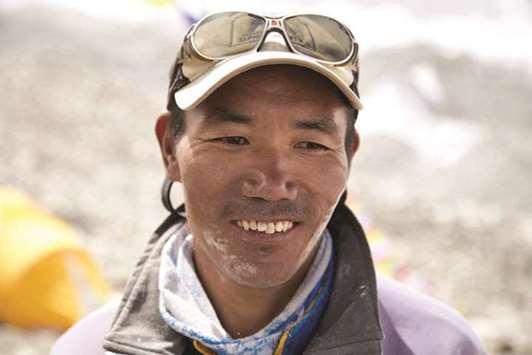People climb Everest for different reasons.
Some, having accomplished similar feats of endurance, like running a marathon, want to push their limits to the extreme.
Others just want to add Everest to their resumes.
Then there’s Kami Rita Sherpa, a 47-year-old mountain guide, who is set to break his own record on Everest sometime later this month by summiting it for a 22nd time.
Three people, all of them members of the Sherpa community indigenous to the Nepalese Himalayas, currently share the record for the most summits on Everest.
Apa Sherpa, Phurba Tashi Sherpa and Kami Rita Sherpa have each climbed it a record 21 times.
Sherpas, ethnic Tibetans who migrated to Nepal about 600 years ago, live in the shadow of some of the world’s tallest mountains in eastern Nepal.
The famed mountain people, who work as porters, guides and managers and can earn between $5,000 and 10,000 in one season, form the backbone of Nepal’s climbing
industry.
In 2013, when Phurba Tashi scaled Everest, he tied the record of legendary climber Apa Sherpa, who quit climbing Everest after his 21st ascent in 2011.
Phurba Tashi, who recently climbed the 8,156m peak of Manaslu in Nepal, has said he has no plans to summit Everest again.
Kami Rita, the veteran guide, left for Everest last month.
Before flying to Lukla, the tiny airstrip that serves as a gateway to Everest, he made a crucial move in his two-decade career as a guide.
He quit his long-time employer Alpine Ascents International, a Seattle-based commercial guiding company, and joined Seven Summits Treks, one of a dozen Nepalese-run companies that regularly operate on the world’s highest peak.
Tashi Sherpa, managing director of the company, said he wanted Kami Rita because he was one of the most experienced guides on Everest.
“We cannot calculate his experience in terms of money. Perhaps it’s worth millions of dollars,” he said.
Tashi said Kami Rita would be responsible for helping the company’s 15 foreign clients reach the summit of the 8,848m peak.
“He oversees a group of 20 Sherpas. He will lead the team in setting up camps above base camp and manage logistics,” he said.
Kami Rita is considered one of the strongest and most reliable guides on Everest, said Ang Tshering Sherpa, former president of the Nepal
Mountaineering Association.
But Kami Rita, who grew up in Thame, a village in the shadow of Everest, and started his career as a trekking porter in 1992, is not resting on his laurels.
“I still want to climb Everest two or three [more] times. Then I will set up my own guiding company,” he said.
The intrepid climber, who spends his spare time at base camp playing cards or training younger Sherpas, said that every spring climbing season he worries about whether his clients will reach the summit.
“I am the happiest person after all of my team members return from a
successful summit,” he said.
The father of two teenagers said he doesn’t want his children to follow his path.
“I don’t want them to work on the mountain. They will be better off pursuing their career in other areas after their study,” he said.
It’s a sentiment shared by many Sherpa climbers and guides, particularly after tragedies on Everest in recent years.
Sixteen Sherpas were killed in 2014 when an avalanche hit Khumbu Icefall, the most dangerous part of the route on Everest.
Over half of the 18 people killed in the earthquake-triggered avalanche in 2015 on Everest base camp were local guides and porters, including Sherpas.
The disasters highlighted the risks Sherpas face on the mountain and prompted the government, which charges a foreign climber $11,000 for a climbing permit on Everest, to reform the sector by increasing insurance from $5,500 to $11,000 and making it mandatory for climbers to hire guides.
But for Kami Rita, these changes are still not enough.
“Our government hasn’t done much for us. We are famous around the world. Many foreigners know us, but our government doesn’t care about us,” he said.
He recalled how the government failed to provide support to Ang Rita Sherpa, nicknamed “Snow Leopard,” who climbed Everest a record 10 times without supplemental oxygen, when he was hospitalised in Kathmandu after a brain haemorrhage a year ago.
Before leaving for Everest this season, Kami Rita signed a contract to serve as a brand ambassador for a cement company.
Photos of him and local personalities including an ultra-runner named Mira Rai were featured in the company’s advert in Nepalese newspapers last month.
He has also been rewarded with trips abroad from his clients.

Kami Rita Sherpa
